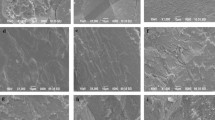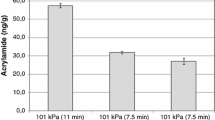Abstract
Studies were carried out to determine the effect of baking, in different types of oven such as an earthen tendoor, a gas tandoor, an electric oven and a heated plate, on the physico-chemical and quality characteristics of tandoori roti. The studies indicated that the extent of gelatinization of starch varied depending on the type of oven used and was found to be 74.6, 78.4, 90.7 and 88.4% in roties baked in an earthen tandoor, a gas tandoor, an electric oven and a heated plate respectively. The pasting characteristics of starch, separated from the tandoori roti sample and measured using a Rapid Visco Analyzer, indicated the highest peak viscosity (36 SNU) for tandoori roti baked in an earthen tandoor and the lowest (25 SNU) for that baked in an electric oven. The concentration of high molecular weight proteins was lower in roti baked in an earthen tandoor and a gas tandoor, indicating greater dissociation of high molecular weight proteins during baking in such ovens. The sensory texture, taste and flavour of roti baked in an earthern tandoor was found to be superior to those baked in other types of ovens.
Similar content being viewed by others
References
Saxena DC, Rao PH, Rao KSMS Raghava (1995) J Food Eng 26: 209–217
Matz JA, Matz TD (1978) Ovens and Baking. In: Cookie and cracker technology, 2nd edn. AVI, Westport, Conn., p. 288
Walker CE (1987) Impingent oven technology-Part I. American Institute of Baking. Technical Bulletin IX (11)
Pyler EJ (1988) Baking science and technology, 3rd edn. Sosland, Kansas City, Mo., p 1184
Saxena DC, Rao PH (1996) Sci Aliments (in press)
Rao PH, Leelavathi K, Shurpalekar SR (1986) Cereal Chem 63: 297–303
Approved methods of the American Association of Cereal Chemists. AACC, St. Paul, Mn. 1983
Chiang BY, Johnson JA (1977) Cereal Chen 54: 429–435
Steel GD, R Torrie JH (1960) Principles of statistics. Mc-Graw Hill, New York
Walker CE (1993) Principles of baking—heat transfer, how and why? Presented at the American Institute of Baking, short course on Grain Foods Process Systems Technology, 28–30 June 1993
Yasunaga T, Bushuk W, Irvine GN (1968) Cereal Chem 45: 269–279
Faridi HA, Rubenthaler GL (1984) Cereal Chem 61: 151–154
Morad MM, D'Appolonia BL (1980) Cereal Chem 57: 239–241
Mousa ET, Ibrahim RH, Shuey WC, Maneval RH (1979) Cereal Chem 56: 563–566
Jeanjean MF, Damidaux R, Feillet P (1980) Cereal Chem 57: 325–331
Author information
Authors and Affiliations
Rights and permissions
About this article
Cite this article
Saxena, D.C., Rao, P.H. Effect of different baking modes on the physico-chemical and sensory characteristics of tandoori roti. Z Lebensm Unters Forch 203, 262–267 (1996). https://doi.org/10.1007/BF01192875
Received:
Issue Date:
DOI: https://doi.org/10.1007/BF01192875




